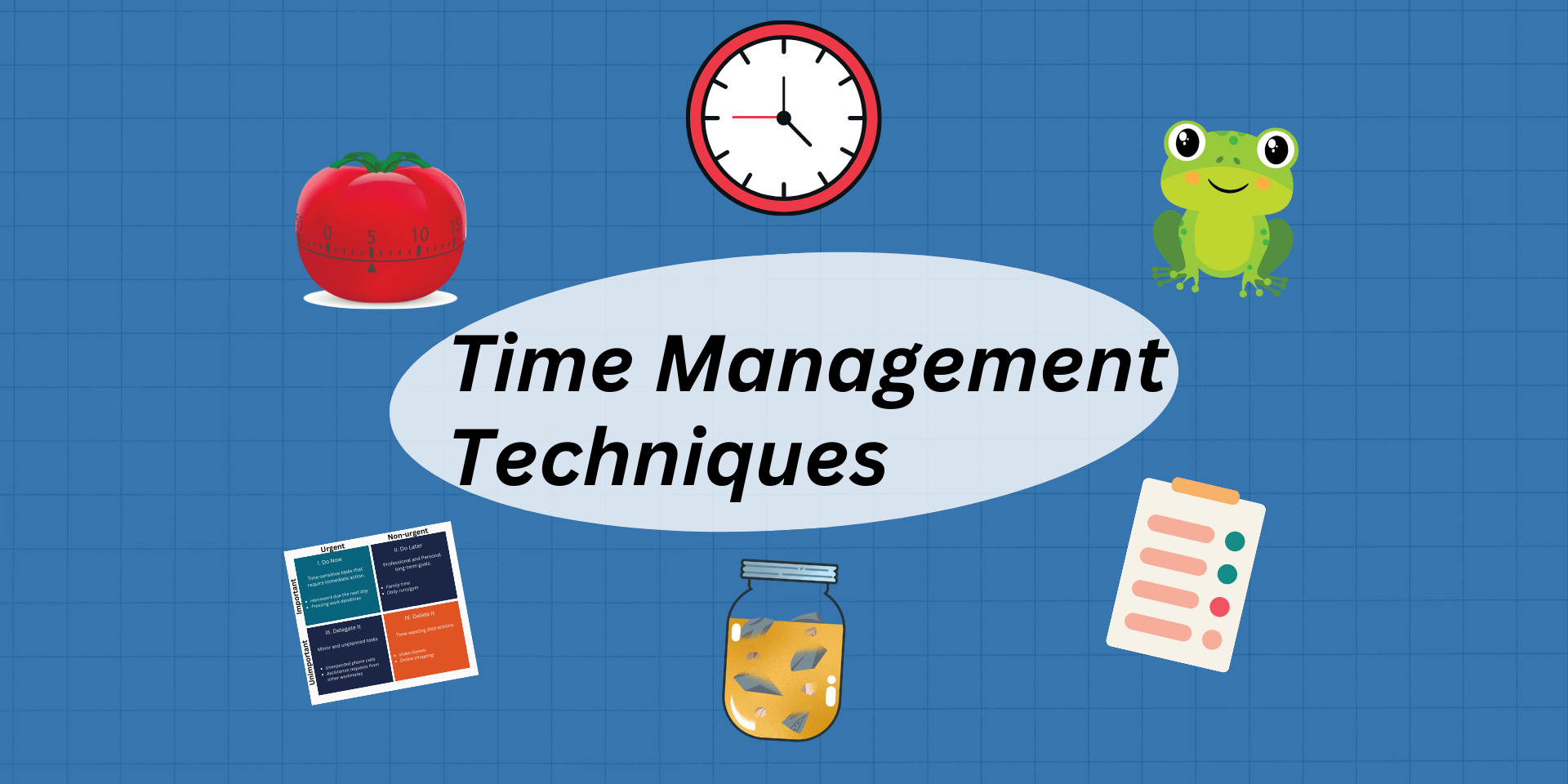

A Student's Guide to Effectively Mastering Time
Time management is essential for personal and professional success. It helps individuals make the most of their time, leading to increased productivity, reduced stress, and improved overall well-being.
Figuring out a process that works for you is key to managingmost of your time. If you’re a student aiming for high remarks, managing your time may be different from how a working mother manages her time.
But don’t worry, we got you! To help you in managing your time, we’veprovided a few time management techniques below. Feel free to try each and every one of them.
1. Pomodoro Technique
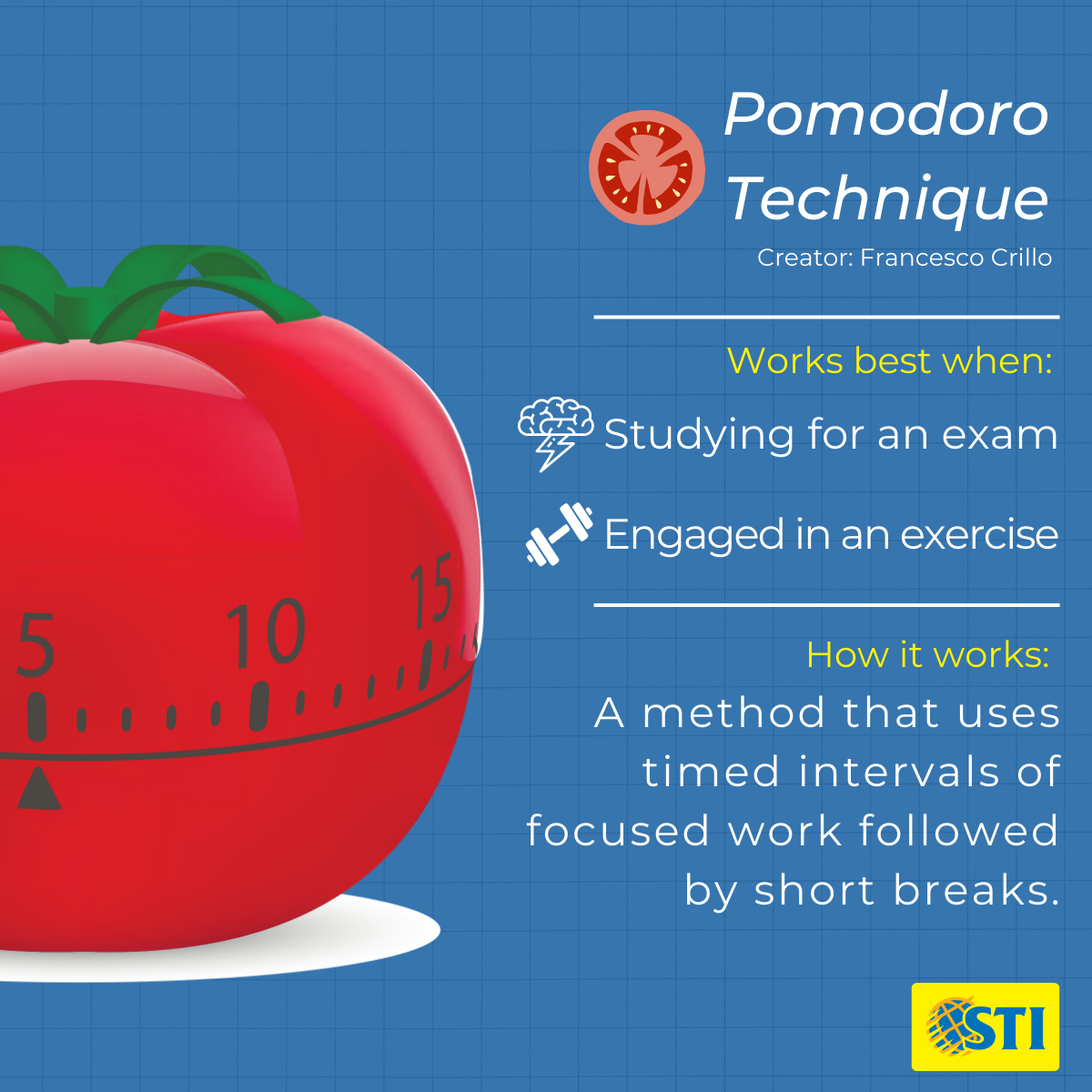
Developed by Italian Francesco Crillo, the Pomodoro Technique is a time management method that uses a timer to break work into intervals, typically 25 minutes of focused work followed by a short 5-minute break.
Step 1: Decide on a task that you will do and grab a timer. It could be a stopwatch, alarm clock, or cellular phone, whichever is convenient for you.
Step 2: Set your timer for 25 minutes and work on your chosen task. Avoid any distractions and try to stay solely focused on this step. This will be your work interval, also known as the Pomodoro.
Step 3: When the timer rings, record your progress and take a 5-minute break. This will allow your brain to relax and recharge before the next Pomodoro.
Step 4: Once the break is over, set the timer again for 25 minutes and continue working on your selected task. Once the timer rings, take another 5-minute break. Repeat this cycle until you complete a total of four Pomodoros.
Step 5: After completing five Pomodoros (four 25-minute work intervals and four 5-minute breaks), take a longer break of 15 to 20 minutes. This will condition your mind not to take in too much unnecessary information.
Step 6: Continue the cycle until you finish the task. Track how many numbers of Pomodoros took you to finish the task. This will help you measure your productivity and identify areas for improvement.
And you’re done. That’s basically it! The Pomodoro Technique is a simple and effective time management method that can help improve focus, productivity, and manage time efficiently. Remember to adjust the intervals and break times to suit your preferences and work style. Happy Pomodoro-ing!
2. Eisenhower Matrix
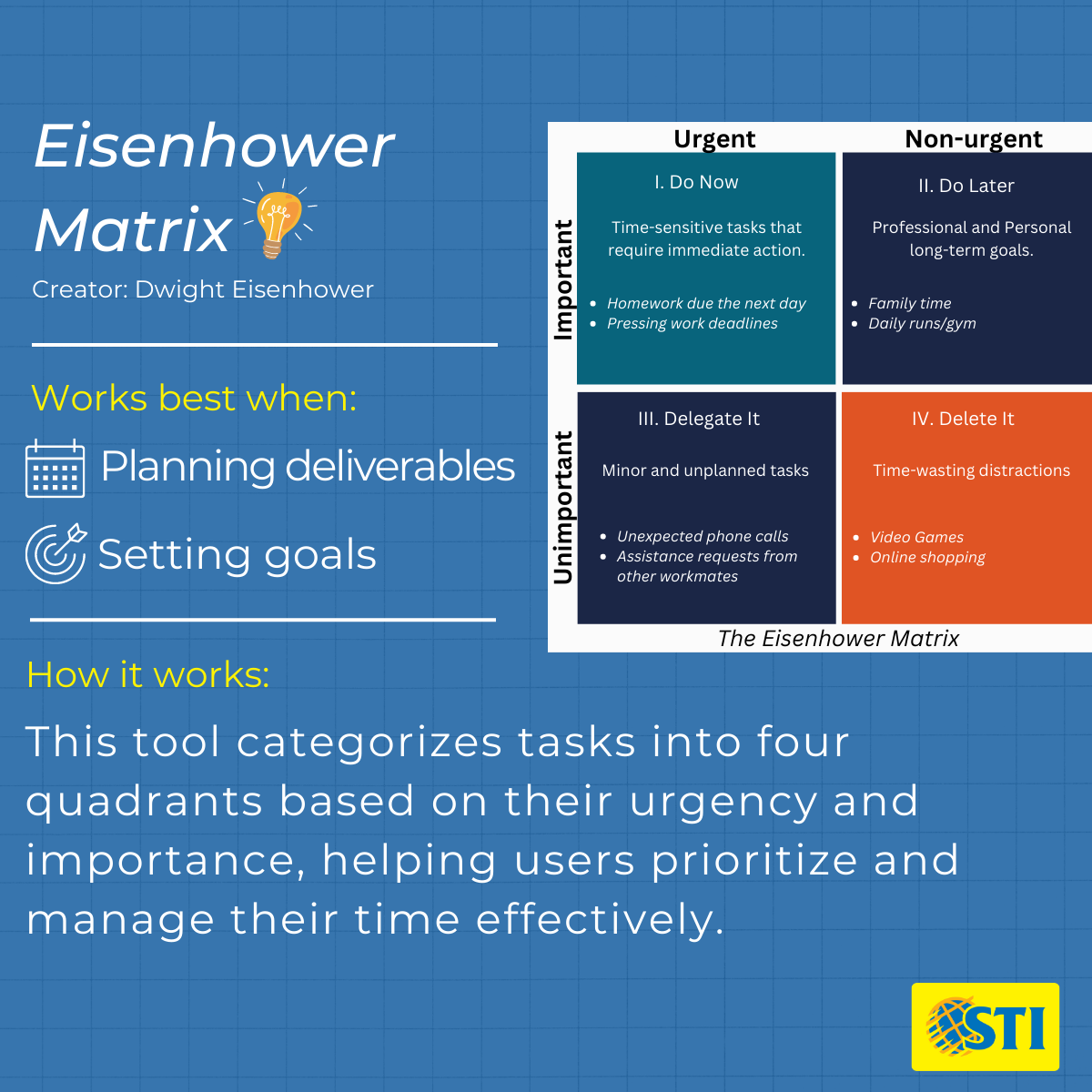 Also known as the Urgent-Important Matrix, this time management tool is used to prioritize tasks based on their urgency and importance. It was popularized by former U.S. President Dwight D. Eisenhower, who was known for his efficient time management skills.
Also known as the Urgent-Important Matrix, this time management tool is used to prioritize tasks based on their urgency and importance. It was popularized by former U.S. President Dwight D. Eisenhower, who was known for his efficient time management skills.
Step 1: Draw a square or rectangular matrix with four quadrants.
Step 2: Label each quadrant with four categories: “Urgent and Important”, “Important but Not Urgent”, “Urgent but Not Important”, and “Not Important and Not Urgent". You can also use abbreviations such as “UI”, IN”, “UN”, and “NN” respectively.
Step 3: Assess tasks, activities, and commitments you need to prioritize and place them in the appropriate quadrant based on their urgency and importance. Urgent tasks require immediate attention, while important tasks are those that align with your long-term goals and priorities.
Step 4: The “UI” quadrant should have tasks that need immediate attention. Begin working on them and complete them as soon as possible.
Step 5: The “IN” quadrant should contain tasks that are important but do not require immediate action. It could help to schedule time in which you will accomplish them effectively.
Step 6: For the “UN” quadrant, these tasks can be delegated to others or eliminated altogether, as they may not directly contribute to your long-term goals.
Step 7: Tasks for the “NN” quadrant, meanwhile, can be eliminated completely from your to-do list to avoid wasting time and energy on low-value activities.
Step 8: Review and update your Eisenhower Matrix as new tasks and priorities come up. You might be surprised some “UI” tasks become “NN” as time goes by.
By using the Eisenhower Matrix, you can effectively prioritize tasks, manage your time, and focus on what truly matters, helping you become more productive and efficient in your daily life.
3. Pickle Jar Theory
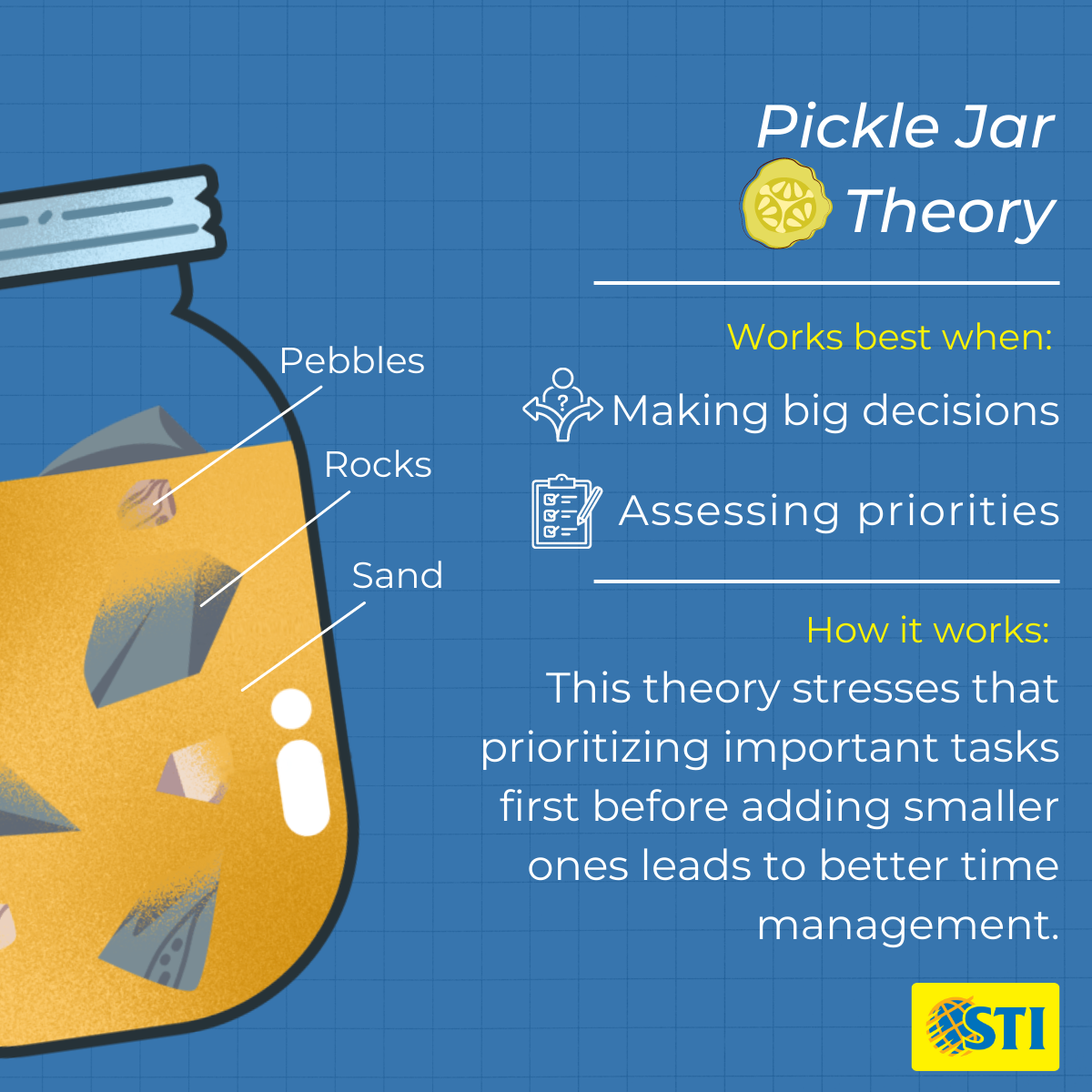
Created by Jeremy Wright, the pickle jar theory is a metaphor that can be used to explain how we prioritize and manage our time, energy, and resources.
Step 1: Imagine an empty pickle jar. The empty space represents your daily time and energy.
Step 2: Imagine having a couple of rocks, pebbles, and a grain of sand. These represent your priorities and the level of significance they belong to.
The rocks represent our most important priorities. These are tasks or activities that have the highest significance in your life, such as family and health; therefore,it should always be put first.
The pebbles represent routine tasks and daily responsibilities; such as school or work tasks, friends, or other commitments. They possess the utmost importance but are not as essential as rocks.
The sand signifies the small stuff such as leisure, social media, video games, and other material possessions. Just as sand fills the empty spaces between the rocks and pebbles, these small things fill the gaps in our daily lives and give us respite from the hardships of life.
Step 3: Fill the empty jar with the rocks first. The gaps between each rock leave enough space for the pebbles to be poured in next. The tiny gaps remaining will then be for the sand. This is a representation of what to put first in our daily lives.
Now, if you were to reverse the order of filling the jar and add the sand first, there would not be enough room for the rocks and the pebbles. The same principle applies to your life. If you spend too much time on the small stuff you won’t have enough time to focus on the things that are truly important, the big rocks.
Step 4: Regularly review and adjust. It's important to regularly review and adjust your priorities as time progresses. Just like you may need to subtract old rocks to create space for new ones, you may need to re-evaluate your priorities and make adjustments based on changing circumstances or goals.
Step 5: Be mindful of overflowing the jar too. Similarly, in life, it pays to be mindful of your daily capacity. If you take on too many tasks or commitments, you may become overwhelmed and suffer from burnout or stress.
Remember, the pickle jar theory is a metaphorical framework that can help you manage your time, energy, and resources effectively. By identifying your priorities, allocating your resources wisely, and being flexible to adapt to changes, you can lead a more balanced and fulfilling life.
So, prioritize the big rocks first. Practice self-care, spend quality time with the people you love, and the rest is just pebbles and sand - they will always find some space.
4. Eat That Frog Technique
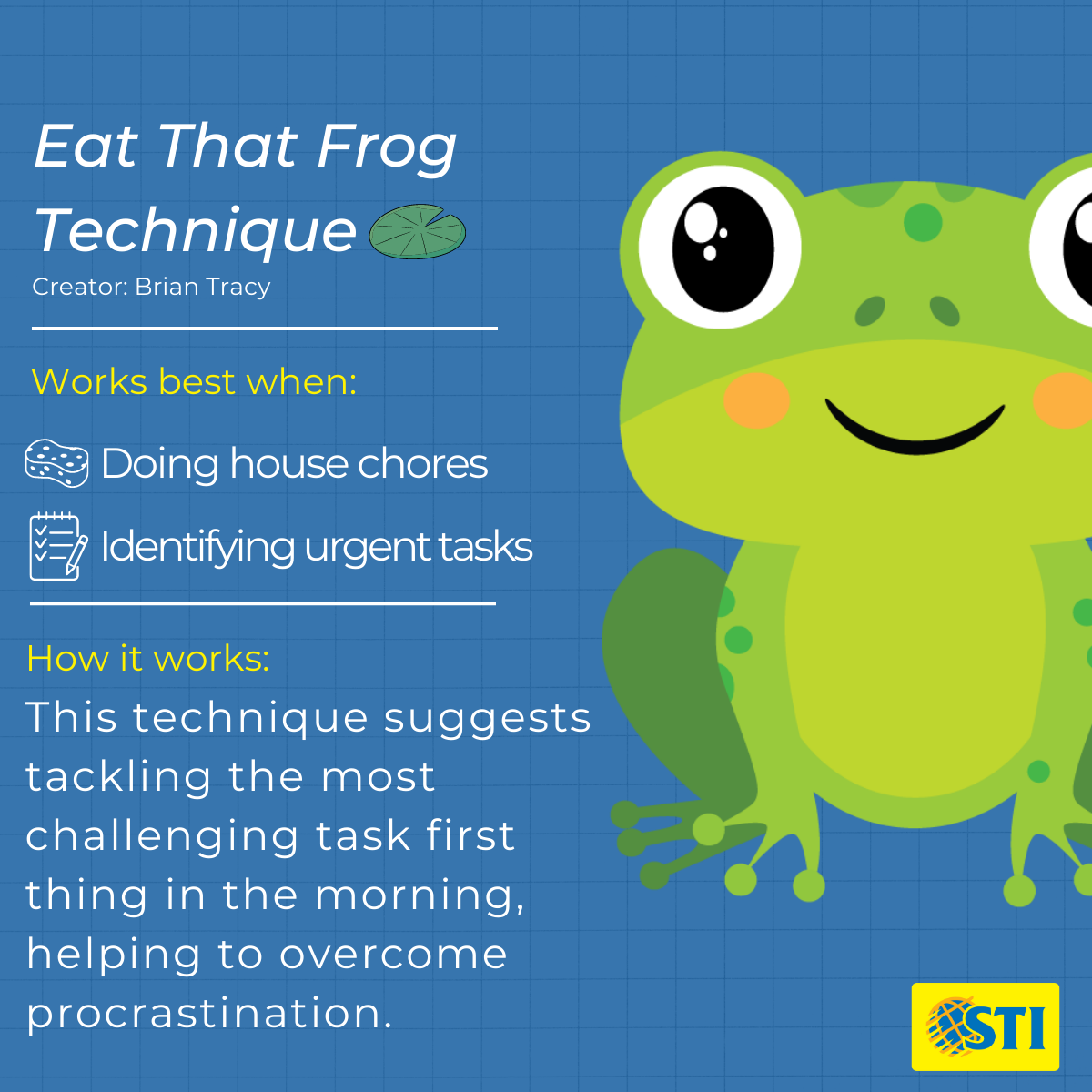 Created by Brian Tracy, this techniquetackles the most challenging or important task first thing in the morning. By completing the most daunting task early in the day, you can gain momentum and productivity for the rest of the day.
Created by Brian Tracy, this techniquetackles the most challenging or important task first thing in the morning. By completing the most daunting task early in the day, you can gain momentum and productivity for the rest of the day.
Step 1: Take a look at your to-do list or list of tasks and identify the one that is most important or has the highest priority. This is your "frog" that you need to eat.
Step 2: Define the outcome you want to achieve with the task. Be specific and set a clear goal that you can work towards.
Step 3: Break down the task into smaller, manageable steps and prioritize them based on urgency and importance. This will help you create a roadmap to complete the task efficiently.
Step 4: Minimize distractions and create a conducive environment for focused work. Turn off notifications on your phone, close unnecessary tabs on your computer, and find a quiet space to work.
Step 5: Start working on the task without delay. Avoid procrastination and take action immediately. Remember to stay focused and avoid multitasking.
Step 6: Stay motivated and committed to completing the task. Remind yourself of the benefits of completing the task and the sense of accomplishment you will feel afterwards.
Step 7: After completing the task, take a moment to reflect on the process and evaluate what worked well and what could be improved. Adjust your approach accordingly for future tasks.
The "Eat That Frog" technique can primarily help you overcome procrastination, increase productivity, and achieve your goals more efficiently. Remember to stay disciplined and consistent in applying this technique to see positive results in your time management and productivity.
5. Getting Things Done (GTD)
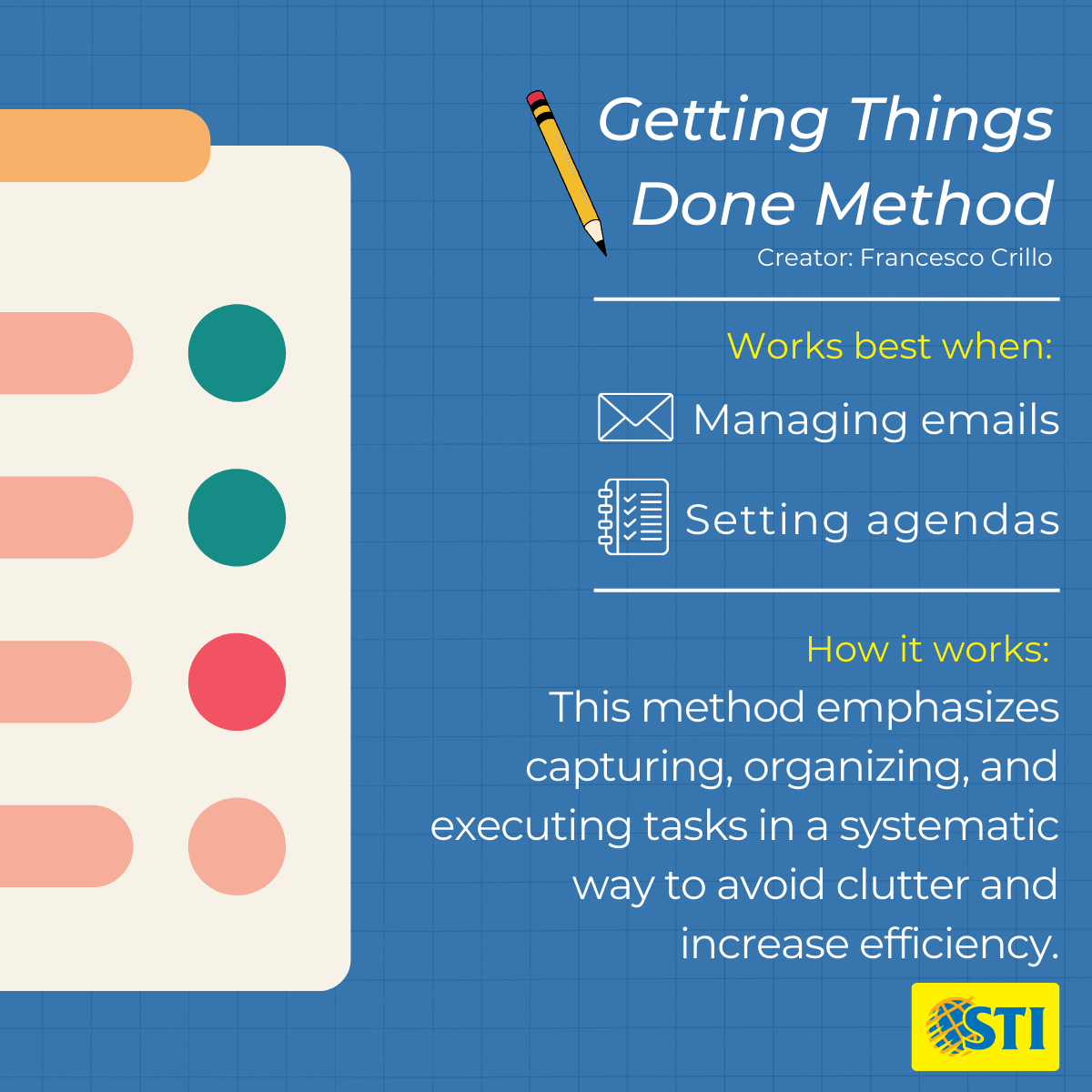 This technique was developed by David Allen in his book titled "Getting Things Done: The Art of Stress-Free Productivity." It focuses on capturing, organizing, and processing tasks and information to help individuals achieve a state of clarity and control over their work and life.
This technique was developed by David Allen in his book titled "Getting Things Done: The Art of Stress-Free Productivity." It focuses on capturing, organizing, and processing tasks and information to help individuals achieve a state of clarity and control over their work and life.
Step 1: List all your tasks, ideas, and commitments from short-term to long-term. This helps you get everything out of your head and into an organized system.
Step 2: Process each item in your list one by one and determine the next action needed. If it takes less than two minutes to do, do it immediately and eliminate it from the list.
Step 3: Review your lists regularly to ensure everything is up to date and aligned with your goals and priorities. Reflect on your progress, adjust, and plan your next actions accordingly.
Step 4: When it's time to work, focus on the tasks that are most important and aligned with your goals. Use your organized list to guide you in choosing what to work on next and avoid getting overwhelmed or distracted.
Step 5: Finish tasks as efficiently and effectively as possible. Celebrate your progress and check off completed tasks from your lists to experience a sense of accomplishment.
Step 6: Continuously capture, clarify, organize, reflect, engage, and complete tasks as part of your regular workflow. Maintain discipline in keeping your system up to date and following the GTD methodology consistently.
By implementing the GTD technique, you can increase your productivity, reduce stress, and achieve a greater sense of control over your tasks and commitments.You'll be surprised that it has already become a habit and a part of your daily routine.
6. Pareto Analysis (a.k.a., the 80/20 rule)
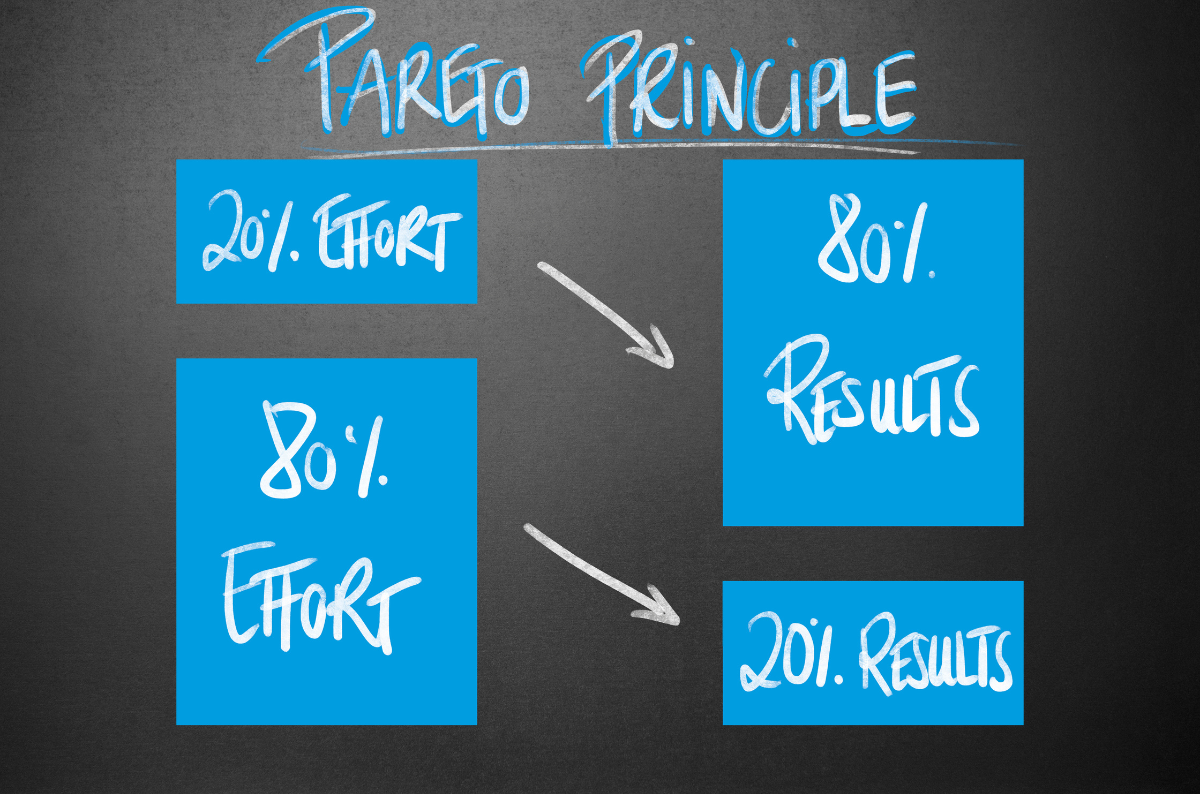
Created by Vilfredo Pareto, is ideal for analyzing and prioritizing activities or tasks based on their level of importance and impact.
Also known as the "80/20 rule", it is a data-driven decision-making technique that was developed by Italian economist Vilfredo Pareto and states that in many situations, approximately 80% of the effects or results are caused by 20% of the causes or inputs.
Step 1: List the problems you are currently facing. It may be your grades slipping or projects getting untracked
Step 2: Identify the root of each problem. Spending too much time on social media or playing too much video games might be the reason your grades are getting low.
Step 3: Group other problems that have a similar cause to your main problem. In this case, compile all your setbacks you think were caused by spending too much time on social media or by playing too much video games.
Step 4: Determine the impact of spending too much time on social media/playing too much video games on your setbacks and how it affects each one of them.
Step 5: Create a chart representing the impact of the cause of each problem. This is called the Pareto chart. The categories with the highest frequency or impact will be plotted on the left-hand side of the chart, while the categories with the lowest frequency or impact will be plotted on the right-hand side.
Step 6: Review the Pareto chart and identify the vital factors that contribute most to the problem or goal. These are the factors that should be prioritized for action.
Step 7: Develop and implement strategies or solutions to address the critical factors identified through Pareto analysis. In this case, a disciplined approach to lessening screen time might be a good solution to improving your grades.
Pareto Analysis can be a valuable tool for prioritizing efforts and resources, identifying areas for improvement, and achieving more efficient and effective results. By focusing on the critical few factors that contribute to the majority of the outcomes, you can hit two birds with one stone as you optimize your efforts and achieve better results in your personal or professional endeavors.
7. Parkinson’s Law
Parkinson's Law is based on the saying "work expands to fill the time available for its completion." In other words, tasks tend to take longer than necessary due to inefficiencies, distractions, and lack of focus.
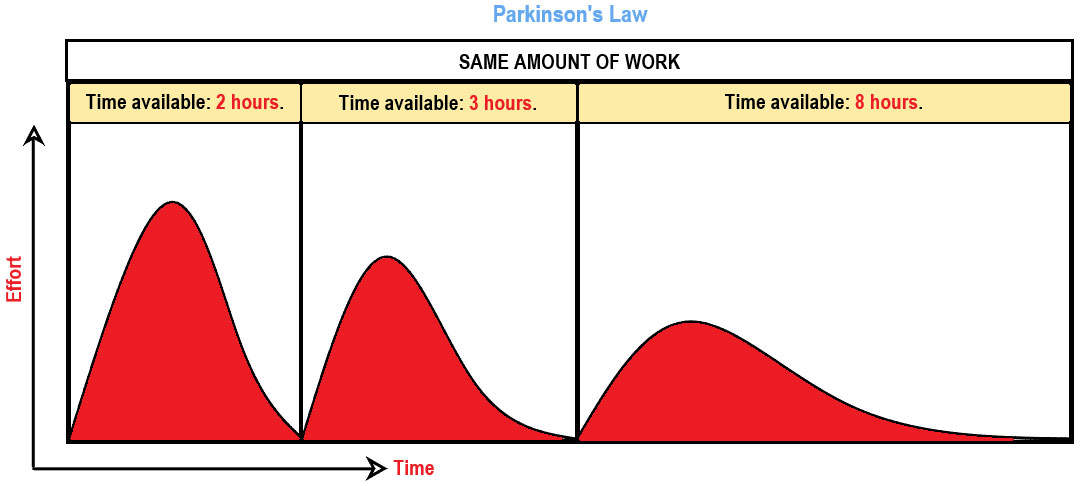
A brief representation of the Parkinson’s Law. (Photo courtesy of Surajc)
Step 1: Start by identifying the specific task or project that you want to work on.
Step 2: Set a specific deadline for completing the task. Make sure the deadline is realistic and achievable, but also a bit challenging to encourage productivity.
Step 3: Remove any potential distractions from your environment. Turn off notifications on your phone, close unnecessary tabs on your computer, and find a quiet place to work.
Step 4: Break the task down into smaller, manageable sub-tasks. This will help you to better understand the scope of the task and avoid feeling overwhelmed.
Step 5: Focus on the essentials. Identify the essential components of the task that need to be completed to consider it "done." Avoid getting caught up in unnecessary details and prioritize the most critical aspects of the task.
Step 6: Avoid taking on too many tasks or commitments simultaneously, as it can lead to inefficiency and delays. Learn to say "no" when necessary and prioritize your tasks based on importance and urgency.
Step 7: Hold yourself accountable to the deadline you set. Regularly review your progress and adjust as needed to stay on track.
Step 8: After completing the task, take some time to review your process and learn from it. Identify any areas where you could improve your efficiency or time management skills for future tasks.
The idea behind this technique is that the amount of time you set for yourself to finish a task is the amount of time it will take to complete such. By following these simple steps and being mindful of how time is allocated, this can be established as an effective habit.
8. Time Blocking Method
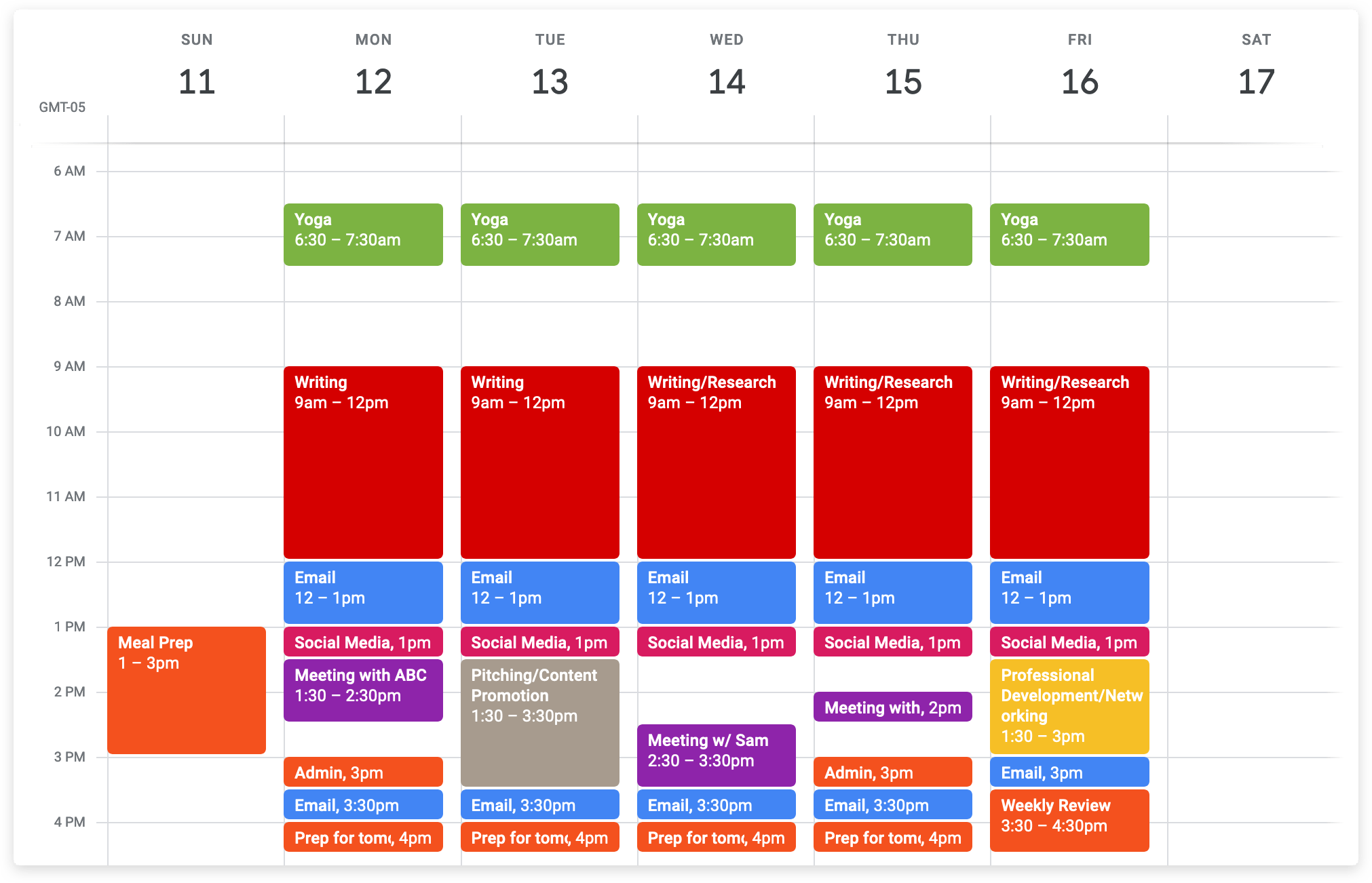
An example of a Time Blocking list. (Photo courtesy of Todoist)
From the moment you wake up, assign each time block in your day to a task. These tasks can be anything from eating breakfast to studying for a test. Below are the steps may use to block your time:
Step 1: Divide a piece of paper into two columns. On the left, write down each hour of the day and create blocks of time such as half-hour or chunks of hour
Step 2: Estimate the time it’s going to take to complete each of your activities, from taking a bath, eating, and getting dressed, and fit them into your time blocks.
Step 3: Follow your time blocks diligently and try to avoid going over the allocated time for each task all throughout the day. Stay focused and disciplined during each time block and resist the temptation to multitask or get distracted.
Step 4: Be prepared to adjust your time blocks as needed. Unexpected events or changes in priorities may require you to shift or reschedule tasks. Add buffer times in between each block to be flexible and adapt to your schedule accordingly.
Step 5: After each day or week, review how well you stuck to your time blocks and assess your productivity. Identify any areas where you can optimize your time management or make improvements for future time blocks.
Step 6: After a thorough assessment, try to maintain a consistent schedule and use time blocking as a regular practice to enhance your productivity and manage your time effectively.
This technique can be a powerful tool to help you stay organized, focused, and productive. By scheduling dedicated time blocks for tasks, you can make the most of your time and ensure that important tasks are completed efficiently and effectively.
9. Rapid Planning Method
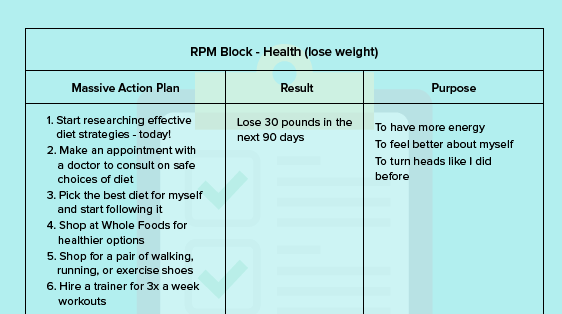
An example of a Rapid Planning chart. (Photo courtesy of Tony Robbins)
Also known as “Result, Purpose, and Massive action plan”, it was developed by motivational speaker Tony Robbins to train your brain to focus on a vision of what you want so you can make it real.
Step 1: Clearly define the specific outcome or goal you want to achieve and jot it down on a list of paper.
Step 2: On the top of a new sheet of paper, make three columns: the task, the result you want from completing that task, your purpose for completing it, and the actions you must take to get there.
Step 3: Within each category, prioritize the tasks based on their importance and urgency. Use criteria such as deadlines, impact on your outcome, and feasibility to determine the priority of each task.
Step 4: When you’re done with all the tasks, identify if you have met the goal you set for yourself. Assess each task and look for areas for improvement.
By following these steps of the RPM, you can effectively clarify your goals, prioritize your tasks, and act towards achieving your desired outcomes in a systematic and efficient manner.
Choosing a Time Management that Works for You
Remember, finding the right time management technique is a personal journey, and it may take time and effort to identify the approach that works best for you. Stay patient, be willing to try new methods, and continuously assess and adjust your approach to optimize your time management skills.
Whether you’re a full-time or a working student, time management skills are essential to living a well-balanced life. So, if you have developed a habit of leaving things until the last minute, or you're having trouble focusing on the task at hand, feel free to try and develop these time-saving life hacks. Time, after all, is the most valuable thing an individual can spend.




